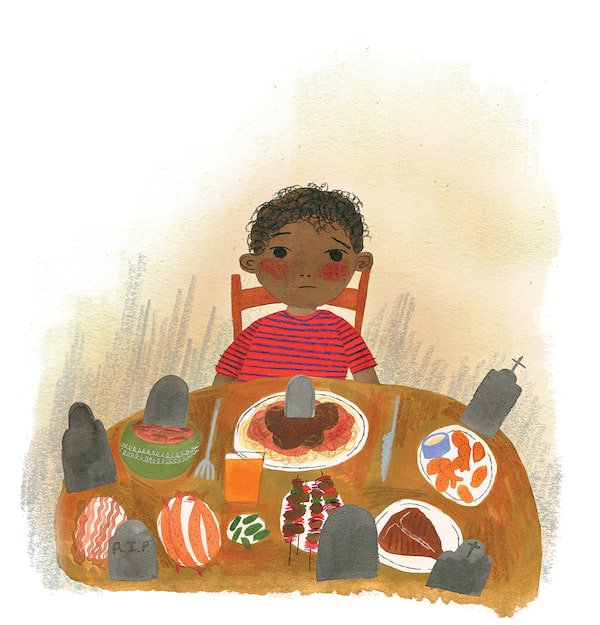
Chelsea O'Byrne
First Person is a daily personal piece submitted by readers. Have a story to tell? See our guidelines at tgam.ca/essayguide.
Bacon was one of my son’s favourite foods, right up there with ice cream and chocolate. At least it was until last summer, when he asked the seemingly harmless question: “Dad, how do they make bacon?”
I hesitated for a moment, knowing my five-year-old wouldn’t like my answer. Bacon comes from pigs, I finally said.
“Dead pigs?” he asked, slightly skeptical.
I nodded. “Dead pigs.”
He stopped chewing the bacon strip that he’d been enjoying and slid his plate away. He started asking me other questions. How did this pig die? Who killed the pig? And exactly where on the pig does bacon grow?
I did my best to answer each of these, with varying degrees of success. I explained that there are farms that raise certain types of animals and that the farmer, well, he kills them from time to time. I wasn’t sure how the pig died, I said (I realized that I knew embarrassingly little about said pig’s life).
Bacon, I said with more certainty, comes from the pig’s back and sides. I grabbed a bit of fat at my waist to demonstrate.
My son listened intently, all the while leaving the food on his plate untouched.
Over the next few days, he began asking about other foods and whether they, too, came from “dead animals.” A loaf of bread, for example. French fries. Spaghetti. A cheeseburger.
Burgers come from cows, I said.
“Dead cows?” he asked. He had the same look of shock and guilt as when he’d learned the origins of bacon. And much like the bacon revelation, I felt as if I’d pulled the rug out from under him again.
In the end, it was a humble turkey sandwich that did him in. In this case, my son had never connected the turkey that we ate for holiday dinners with the turkey he saw on various cartoons making a funny gobble-gobble sound. And I had never bothered to set him straight.
“This is a dead turkey?” he said. This time he didn’t have to wait for my response.
He put the sandwich back on his plate and slid it toward me. He wouldn’t eat the rest of it, he said. Or any other animals. From now on, he told me, he would be a “plant-eater.”
That night, my wife and I talked it over. We would adjust our meals to be meat-free, and we’d find ways to ensure he got enough protein. It was likely just a phase, we thought. It would pass within a few weeks.
But the more I thought about it, the more I struggled to justify why I ate meat in the first place. In university, I’d dabbled (unsuccessfully) with being a vegetarian. For years since, I’d told myself that I didn’t eat that much meat. In truth, I ate it nearly every day, often for both lunch and dinner.
Why? Because meat tastes good. It’s filling, and – perhaps, most importantly – it’s convenient. But my five-year-old had raised a deeper question: was eating meat the right thing to do?
At a gut level, I knew the answer. I’ve always had ethical concerns about how livestock are raised on large, industrial-scale farms. I’ve also been aware of the environmental impacts (runoff from feedlots can foul rivers and streams, forests are often cleared to make way for cattle ranges, not to mention livestock releases a huge amount of greenhouse gas emissions).
Prompted by my son’s decision, I decided to take the leap: I, too, would become a plant-eater. My wife, thankfully, got on board as well. We set off for the library to get some vegetarian cookbooks and began to adjust our grocery shopping. If nothing else, I thought, we’ll eat a bit healthier.
Going meat-free was not easy for me, at least not at first. I’m a slim guy with a fast metabolism. Without meat, I found myself eating constantly in order to stave off hunger pangs. I munched through bag after bag of trail mix. I ate far too many boiled eggs and I missed certain dishes (there’s no substitute for butter chicken).
But gradually, things did get easier. My eating habits changed (no more fast food for lunch). My body adjusted. I started to like how I felt when I didn’t eat meat – lighter, and somehow more clear-headed. I also liked feeling as if I was doing my part for the planet, as small as that may be.
The “vegetarian phase” stretched to a month, then two. It’s been just more than a year now, and my son shows no signs of letting up. I’ve seen him peel pepperoni off a pizza and politely turn down a hot dog at a birthday party (luckily, he never did ask where hot dogs come from). I’ve been amazed by his fortitude.
I’ve learned that habits are surprisingly powerful. The main reason I ate meat is because I’d always eaten meat. It took weeks, maybe even months, to break that habit and forge new daily routines – to shop differently, cook differently, dine out differently. But once the habit was broken (or changed?), being a vegetarian became a breeze.
I’ve also learned that kids have a moral clarity that adults sometime lose. (Look at the role that teenagers are playing in the gun-control debate in the United States.) Now, when my son asks me a seemingly naive question, I try to pause – and think twice – before explaining it away.
I expect that my son will return to meat-eating again someday. He’s only six after all. And I’ll support him in whatever choices he makes. But for now, we’ll continue enjoying our veggie burgers together, as a family.
Brad Badelt lives in Vancouver.